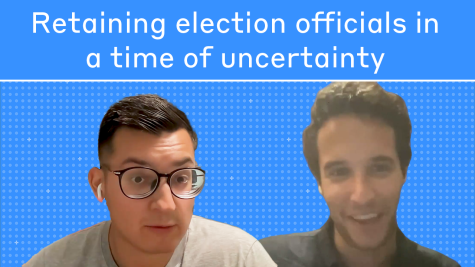Talking Elections: Voter Education
In Episode 3 of our video series Talking Elections, we wanted to take a look at voter education which is an important topic that doesn’t get enough notice in the elections community. There is a lot of information that voters need to know to vote and have their votes counted accurately, from registration deadlines and the documentation they might need to register to the location of polling places, voter identification requirements and how to properly mark their ballots as they’re counted.
There are special challenges in voting in the midst of Covid where things are changing so fast — especially on an emergency basis sometimes within hours of the polls opening. This is why this topic is so relevant now.
We were joined by three guests on this episode: Mara Suttmann-Lea of Connecticut College, Lia Merivaki of Mississippi State, and Veronica Degraffenreid of the Pennsylvania Department of State.
Challenges
What are the challenges that state and local officials face when they design and implement voter education efforts?
Mara: Lia and I have both worked in mapping out what voter education looks like across the states, and it has proven to be a challenging endeavor in and of itself. But there are a couple of things that we have noticed during our research and also just in our conversations that we have with local election officials and state election officials. There is a lack of resources for implementing high-quality voter education plans. This is something that we’ve seen in some of the state statutes. We look at questions about whether mandates for voter education at the local level are funded, but it’s also come up just in conversations that we’ve had with local election officials: about dealing with unfunded mandates for voter education. The centralization, or lack thereof, of authority over voter education within a given state can also be a potential challenge. Oversight and implementing voter education plans can be difficult in states with localities that have a lot of autonomy from their state governments (here in Connecticut that’s the case). Of course some amount of flexibility is needed because different jurisdictions have different needs, but that lack of centralization can be a potential challenge as well.
Also, looking at the scope of voter education across the United States for assessing the quality of voter education as a whole, there’s really a lack of consistency and what those policies look like and having a baseline definition standard of voter education so voters are going to experience a lot of variation in the types of education that they have access to depending on where they live. Of course, this isn’t surprising given what we know about how decentralized election administration is in the United States, but it is something that is worth noting if we think of voter education is something that every voter should have access to.
Shining Stars
What are some exemplary efforts of voter education that others can emulate?
Lia: Just a disclaimer: what is reported is most likely a small fraction of what is actually happening across the states and at the local level because we cannot possibly know and collect all the information that is necessary to make an assessment right. And states don’t really need to reinvent the wheel; we know that there are some things that work, and if done consistently, they can make a difference.
For example, small efforts such as a PSA announcement or printing an ad with a local newspaper or radio — those are standard things that we should expect localities are doing but we’re not really sure they are done uniformly, mainly because of resources.
Some exemplary things that we have observed as a minimum intervention includes sending information to voters before Election Day. That seems intuitive, but it might not be. Of course, you might have to deal with issues with mail returning and that starts a chain of events.
Social media presence: we have seen there are some localities that have been active on social media and they’re out in the community. Voters reach out to their local officials and those officials respond. Now there have been some initiatives to include the community broadly defined, like connecting with local high schools, holding registration drives, and working with other organizations. Connecticut is one of the states that has a competition for high schools to do registration drives. Trying to bring the community along — that’s a great example of how states can build these partnerships and local resources.
Voters rely on their local elected officials and we know that from research that voters trust their local election officials and they seek them for information. So being out there, being proactive and reaching out to the community — we have found these small interventions have been fruitful. Being on the loop constantly is necessary because we have seen that there are some efforts to spread some misinformation or some inaccurate information regardless of the intentions. So local officials have to find a way to be on top of it, to get control over the information flow, because that appears to be the biggest challenge.
In terms of voter education there are many things that can be done and the lack of definition is it challenge but at the same time, states and localities have tools that they can use without necessarily thinking outside the box that “oh we have to find that strategy and that recipe to get everyone at the same time” and that’s easier said than done because voters need different things and they can be reached out in different ways.
Strategies
What strategies have you pursued to get important information out to voters about how things have changed in the midst of the fact that Pennsylvania voting modes were going to be changing anyway?
Veronica: There was historic legislation in Pennsylvania in 2019, which is one of the reasons why I came for a new challenge for myself professionally. They’re going to be doing a lot of new things in this state. Voter outreach and education were very much on the minds of the staff here at the Pennsylvania Department of State.
In 2019, with that historic legislation, all registered Pennsylvania voters can now apply for a mail-in ballot without needing to have an excuse, and they can vote from the comfort of their home. Since this method of voting is new to Pennsylvania, this state was already very much engaged in a program called #Ready2Vote. It wasn’t just an afterthought. We were also helping to educate voters about new voting systems, so those things were already happening prior to the change of the primary. Now, with the change of the primary date, certainly our outreach not only included educating voters about the new voting method but also about letting voters know about the date change and then also what efforts counties would be taking to keep voters and poll workers safe on Election Day, in response to Covid-19.
Voting by mail became even more critical with respect to our outreach as it was the way that voters, if they felt uncomfortable about voting in person on Election Day, could apply for a mail-in ballot. The voter can vote from the comfort of their home.
There’s a dedicated outreach team here with the Pennsylvania Department of State. We meet weekly with other interdepartmental staff, and we discuss and strategize on our outreach efforts. It is part of the business model so that we can quickly adapt as needed and it makes us responsive to our community.
One of the things that we did specifically right after the change of the primary date was update the website because that is the place that most people visit if they want to know what’s happening. Key details included: register to vote on time, request a ballot on time, and now because we’re getting close to that primary date, return your ballot by the deadline.
We quickly adapted our targeted media campaign so that included TV and radio. We mailed a postcard to Pennsylvania households informing them about the new primary date and the option of voting by mail and how to apply online for this.
Social media are part of our campaign efforts. We created a neat unboxing video. If you have kids you know exactly what that is, like open up the make-up or open up the new iPhone to see what that experience is. We recorded a similar video to help educate voters about what to expect when they get their ballot in the mail: what’s in the envelope and then of course what to do with the materials in the envelope and how to return their ballot and with it the effort of do it correctly so it will be counted and send it in on time.
New to our Department are webinars that we’ve been putting out kind of like this because we can no longer go in person and do presentations. Leveraging the use of technology is important. Things have changed in recent years since I first started in elections, so this state is developing methods of sending targeted emails to voters so voters when they apply for either online voter registration or requesting their ballot, they can opt in to receive emails. We also inform voters by email to track that process — i.e., “okay we got your application,” “it’s been processed,” “your ballot is in the mail,” “we got your ballot.” Even now because we’re so close to the election we’re sending targeted emails to voters who have requested a ballot and who have not yet returned their ballot to let them know that we need for you to get your ballot back in time and that the deadline is coming up.
Expectations
When thinking ahead to education for November, what are you learning from this round that you think can be applied? What new and different sorts of things will get implemented in approaching the general election?
Veronica: We’re going to continue to do what we’ve been doing. Part of that is just adapting to change, and certainly listening to the needs of our community and the counties. Our strategy is to always be poised, to be nimble enough to quickly get information out when the information is needed just in time, but being poised to do that quickly. We have an outreach team. We will continue to educate voters about mail-in voting as well as the things that they can do to stay safe even throughout the general election year.
Some new things that we’re considering is maybe adding text messaging after the primary, and we have begun to use trusted validators so that they can help get the message out and so that includes using election officials or athletes or businesses to help expand on that vote-by-mail effort. Pennsylvania’s new law allows for us to continue to know that we have to continue to get information out because there’s so many new things that are in Pennsylvania’s law for this year, and so we’ll continue to do those efforts throughout 2020.


